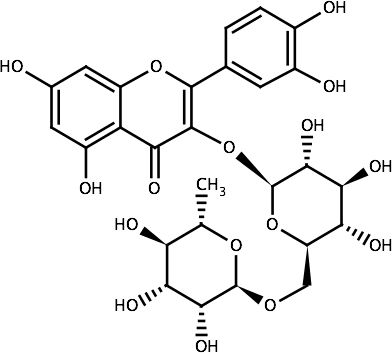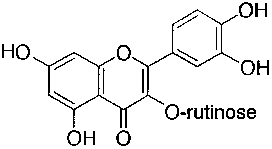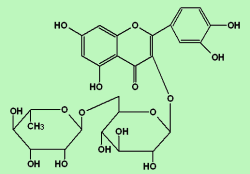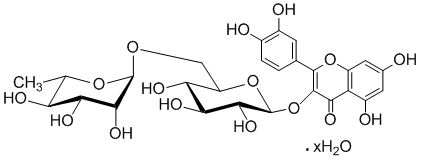Formula C27H30O16 | Appearance Solid | |
 | ||
Rutin, also called rutoside, quercetin-3-O-rutinoside and sophorin, is the glycoside combining the flavonol quercetin and the disaccharide rutinose (α--rhamnopyranosyl-(1→6)-β--glucopyranose). It is a citrus flavonoid found in a wide variety of plants including citrus fruit.
Contents
- Rap line rutin official video hd
- Occurrences
- In food
- Chemical relatives
- Role as ligand
- Animal research
- In veterinary medicine
- Metabolism
- References

Rap line rutin official video hd
Occurrences

Rutin is one of the phenolic compounds found in the invasive plant species Carpobrotus edulis and contributes to the antibacterial properties of the plant.
Its name comes from the name of Ruta graveolens, a plant that also contains rutin.
In food

Rutin is a citrus flavonoid glycoside found in many plants including buckwheat, the leaves and petioles of Rheum species, and asparagus. Tartary buckwheat seeds have been found to contain more rutin (about 0.8-1.7% dry weight) than common buckwheat seeds (0.01% dry weight). Rutin is also found in the fruit of the fava d'anta tree (from Brazil), fruits and flowers of the pagoda tree, fruits and fruit rinds (especially the citrus fruits orange, grapefruit, lemon, and lime) and apple; berries such as mulberry, ash tree fruits, aronia berries and cranberries. Rutin is one of the primary flavonols found in 'clingstone' peaches. It is also found in green tea infusions.
Approximate rutin content per 100g of selected foods, based on the Phenol-Explorer database:

332 mg Capers, spice
45 mg Olive [Black], raw
36 mg Buckwheat, whole grain flour
23 mg Asparagus, raw
19 mg Black raspberry, raw
11 mg Red raspberry, raw
9 mg Buckwheat, groats, thermally treated
6 mg Buckwheat, refined flour
6 mg Greencurrant
6 mg Plum, fresh
5 mg Blackcurrant, raw
4 mg Blackberry, raw
3 mg Tomato [Cherry], whole, raw
2 mg prune
2 mg Fenugreek, fresh
2 mg Marjoram, dried
2 mg Tea [Black], infusion
1 mg Grape, raisin
1 mg Zucchini, raw
1 mg Apricot, raw
1 mg Tea [Green], infusion
0 mg apple
0 mg redcurrant
0 mg Grape [Green]
0 mg Tomato, whole, raw
Chemical relatives
Rutin, like quercitrin, is a glycoside of the flavonoid quercetin. As such, the chemical structures of both are very similar, with the difference existing in the hydroxyl functional group. Both quercetin and rutin are used in many countries as medications for blood vessel protection, and are ingredients of numerous multivitamin preparations and herbal remedies.
Role as ligand
It can combine with cations, supplying nutrients from the soil to the cells in plants. In humans, it attaches to the iron ion Fe2+, preventing it from binding to hydrogen peroxide, which would otherwise create a highly reactive free radical that may damage cells. It is also an antioxidant.
Furthermore, it has been shown to inhibit in vitro the vascular endothelial growth factor in subtoxic concentrations, so acts as an inhibitor of angiogenesis. This finding may have potential relevance for the control of some cancers.
The cannabinoid mediated antidepressant activity of rutin shown in mice models employing weight-loaded forced swim test. Rutin treatment showed upregulation of CB1 receptors in mouse brain tissue demonstrating antifatigue activity and CB1 receptor-interacting proteins. Further, in brain tissues, an increase in expression of peroxisome proliferator-activated receptor-α coactivator (PGC-1α) and sirtuin 1 (SIRT1) was also demonstrated. Integrating together the cannabinoid, PPAR-γ, and opioid receptor activities, rutin may be a potential multitargeted polypharmacological agent in prevention and treatment of diseases involving dysregulation of PPAR and ECS.
Animal research
While a body of evidence for the effects of rutin and quercetin is available in mice, rats, hamsters, and rabbits, as well as in vitro studies, no clinical studies directly demonstrate significant, positive effects of rutin as dietary supplement in humans.
Hydroxyethylrutosides, synthetic hydroxyethyl acetylations of rutin, are used in the treatment of chronic venous insufficiency.
In veterinary medicine
Rutin may have a veterinary use in the management of chylothorax in dogs and cats.
Metabolism
The enzyme quercitrinase can be found in Aspergillus flavus. It is an enzyme in the rutin catabolic pathway.
